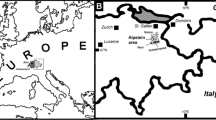Abstract
Tabulate corals are among the more characteristic fossils of the Silurian period, but because only their skeletons have been preserved, their taxonomic position and mode of life have been uncertain. Although they are generally placed1 in the phylum Coelenterata (Cnidaria), the recent discovery of living sclero-sponges that share architectural affinity with some tabulates, has renewed debate about the evolutionary relationships of the latter. In particular, the tabulates have been assigned2,3 to the sponges (phylum Porifera). I report here the discovery of fossilized polyps in a Favosites from the Silurian of Quebec. This incontravertibly demonstrates that the tabulates belong to the phylum Cnidaria, and details of the soft-part morphology suggest that the Tabulata form a group distinct from other corals.
Similar content being viewed by others
References
Hill, D. (ed.) Treatise on Invertebrate Palaeontology Part F, 2. (University of Kansas and Geological Society of America, Boulder and Lawrence, (1981).
Flügel, H. W. Lethaia 9, 405–419 (1976).
Stel, J. H. (1978). thesis, Rÿksuniversiteit Groningen, Netherlands (1978).
Dunn, D. F. & Libermann, Science 221, 157–159 (1983).
Talbot, F. Great Barrier Reef, 95 (Reader's Digest, Sydney, Australia, 1984).
Author information
Authors and Affiliations
Rights and permissions
About this article
Cite this article
Copper, P. Fossilized polyps in 430-Myr-old Favosites corals. Nature 316, 142–144 (1985). https://doi.org/10.1038/316142a0
Received:
Accepted:
Issue Date:
DOI: https://doi.org/10.1038/316142a0
- Springer Nature Limited
This article is cited by
-
Deducing photosymbiosis in extinct heliolitid corals
Coral Reefs (2024)
-
Sclerite-bearing alveolitid favositids from the Devonian of central Poland
Paläontologische Zeitschrift (1993)
-
Fossilführung und Palökologie des lagunären Massenkalkes (Devon) im Sauerland (Rheinisches Schiefergebirge)
Paläontologische Zeitschrift (1988)
-
Euzkadiella erenoensis n. gen. n. sp. ein stromatopore mit spikulärem skelett aus dem oberapt von ereño (prov. guipuzcoa, nordspanien) und die systematische stellung der stromatoporen
Paläontologische Zeitschrift (1987)





